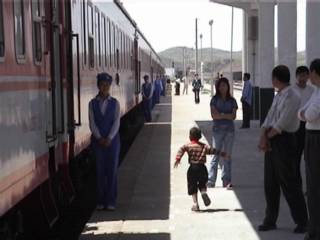
So how does the ball and the FLH team cover the huge distances they have travelled across mainland China? The answer is the excellent Chinese rail network and its fleet of sleeper carriages.
Buying a ticket at a Chinese train ticket office is initially a challenge. There is no Roman alphabet in sight and staff often speak little or no English. The first step is to find out the Chinese characters for your destination of choice…
There are then tables of prices and train times posted along entire walls of the ticket hall or on colourful, animated LED displays, making for metres and metres of incomprehensible symbols. Simply find out which train numbers will get you to your destination at the correct time; match the train number against the columns of ticket options to ascertain the price; join the queue; and, if the booth is still open by the time you get to the front, try to explain everything to the disinterested clerk. There are four types of ticket in China: soft sleeper, hard sleeper, soft seat and hard seat – did you think a Communist country would call them “classes”?
If the ticket you wanted hasn’t sold out, you will soon be leaving the hustle and bustle of the station behind you in exasperated relief, ticket in hand, wondering where to find a bottle of “pijiu” (beer).
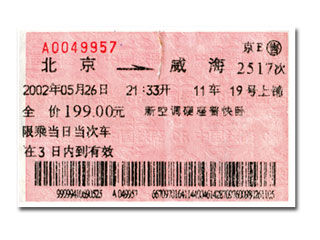
The train stations are grand edifices, usually sporting a stylish gold on red star somewhere on their facade, with waiting rooms for each platform and each ticket type. If you splashed out for the “soft” option, you will be sitting on a plush leather armchair watching satellite TV until your train comes; chose the “hard” option and you get plastic bucket seats and, disconcertingly, less time to board their train.
When the train is ready an army of megaphone wielding station staff are despatched to shepherd the mob along corridors and down stairways with shouted streams of distorted Chinese. There is no chance that you might go the wrong way.
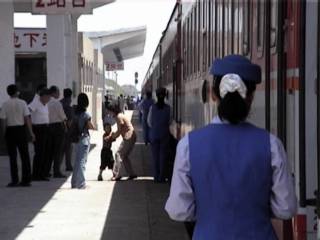
Yes, you are coming with me…
Once aboard, there is a relaxed air as people stow their luggage and sit and chat. We have mainly been using hard sleepers, which cost around UK30 for an overnight 12-15 hour journey and provide a comfortable (not at all hard) bed in an open six-person cabin – the beds are arranged in two columns of three, with the top berth not being advised to those with a nervous disposition or frequent dreams of flying.
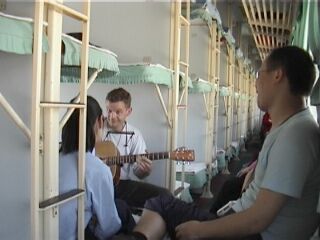
Phil entertains a captive audience in the hard sleeper
You can pass the time sitting on the lower bunks or at small tables by the window. Even better, you can retire to the restaurant car where a compact but fully equipped kitchen is packed full of Chinese chefs throwing stainless steel utensils around and screaming to each other through clouds of steam. The food isn’t at all bad, provided you chose carefully – on my journey to Hangzhou yesterday I mistakenly ordered what I can only imagine would translate as “rice and bones”. Even Chinese diners looked at it doubtfully.
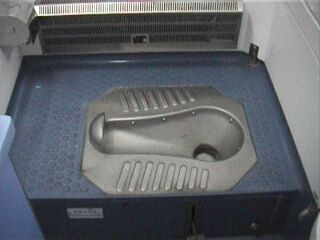
And if the worst comes to the worst – a spotlessly clean Chinese train toilet
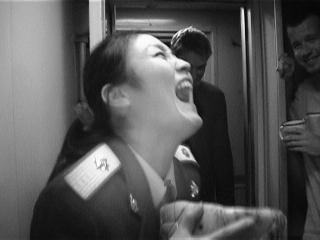
Phil was on the menu for this conductress, however
Later on the restaurant car is where the police officers retire to smoke and drink, and where you too can drink and maybe play Mah Jong, provided the police take a shine to you (and you give em ciggies).
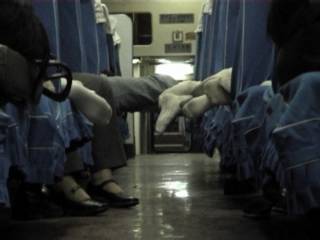
The Hard Seat kippers
If you failed to book a sleeper ticket and want to avoid spending a night sitting bolt upright in a cramped seat or sleeping on the floor, across an aisle or in an overhead luggage rack, you must seek out the mysterious and elusive “upgrades conductor” – the guardian at the gateway to your night of comfort. At rigidly defined, yet undiscolosed times he may be found sitting in semi-darkness at a smoke-shrouded desk half way up the train, poring over scribbled sheets of thin paper and leafing through books of plastic tokens. He is surrounded by a gang of smoking cronies who laugh and cajole you as you approach. Should he grant you an audience, he will nod briefly and then proceed to communicate with you in indecipherable rapid-fire Chinese.
Only a wad of banknotes, waved with just the right degree of enthusiasm, will appease him, whereupon he will scribble further annotations in his various log books before handing you your precious upgrade token.
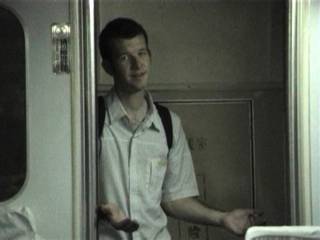
Sorry Tim, no beds left…
Turns out we were kipping in the spare staff bunks right above him actually – he carried on smoking right through the night.
Written by Rob Davis on Tuesday, May 28th, 2002
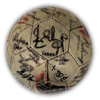
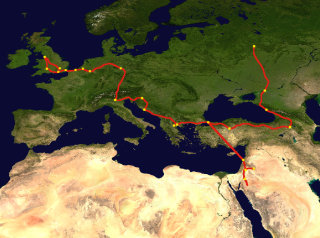
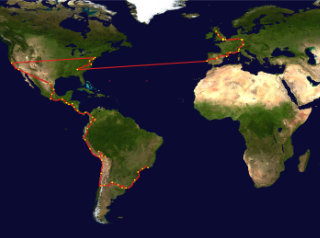
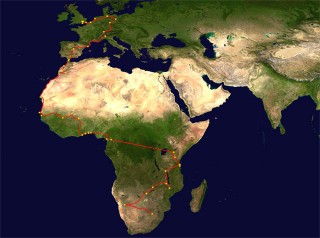
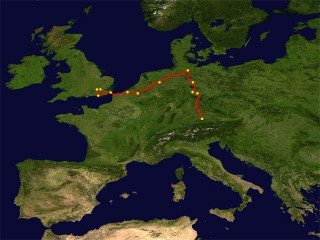
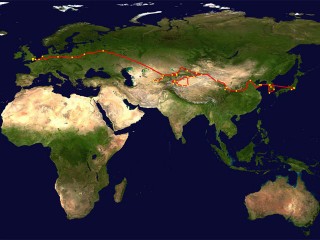





Ah, the guide book scene hits the FLH site. I’m not quite sure what you mean though about the ‘relaxed air as people stow their luggage’ in one of the craziest, sweat inducing scrums, ever.
I loved ’em trains. What a beautiful substitute for a night in a hotel!
Rob, you are mistaken… the Ball needs no passport, no tickets, and no sleeper vouchers. It travels through the power of love. Which is all it needs.
I mean comparative relaxation – its usually just after the mad dash to the station, the frenetic attempts to find the correct platform waiting room and the scrum to get into the carriage.
May the ball’s train journey’s be forever unhindered. Love is all you need. ;)